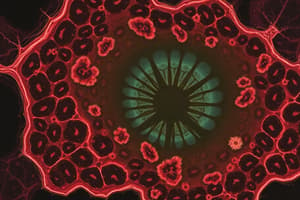Podcast
Questions and Answers
What is cell theory?
What is cell theory?
Cells are the building blocks of all plants and animals, all cells come from the division of preexisting cells, and cells are the smallest units that perform all vital physiological functions.
Which of the following is NOT a function of the plasma membrane?
Which of the following is NOT a function of the plasma membrane?
Cytology is the study of the structure and function of cells.
Cytology is the study of the structure and function of cells.
True (A)
The plasma membrane separates the cytoplasm from the ______.
The plasma membrane separates the cytoplasm from the ______.
Signup and view all the answers
What is the structure of the plasma membrane primarily composed of?
What is the structure of the plasma membrane primarily composed of?
Signup and view all the answers
Which type of proteins are known to span the plasma membrane?
Which type of proteins are known to span the plasma membrane?
Signup and view all the answers
What role do membrane carbohydrates play in the cell?
What role do membrane carbohydrates play in the cell?
Signup and view all the answers
What type of transport requires energy?
What type of transport requires energy?
Signup and view all the answers
Osmosis is the diffusion of solutes across the cell membrane.
Osmosis is the diffusion of solutes across the cell membrane.
Signup and view all the answers
What does it mean for a membrane to be selectively permeable?
What does it mean for a membrane to be selectively permeable?
Signup and view all the answers
In an isotonic solution, the osmotic flow of water in and out of the cell is ______.
In an isotonic solution, the osmotic flow of water in and out of the cell is ______.
Signup and view all the answers
Study Notes
Cell Theory
- Cells are the fundamental units of all plants and animals.
- All cells originate from pre-existing cells through division.
- Cells are the smallest structures capable of performing all vital life functions.
- Each cell maintains its internal stability (homeostasis).
Cytology & Microscopy
- Cytology is the study of cell structure and function.
- Light microscopy (LM), electron microscopy (EM), scanning EM (SEM), and transmission EM (TEM) are used to visualize cells.
Cell Anatomy Overview
- Cells are surrounded by extracellular fluid (interstitial fluid).
- The plasma membrane separates the cytoplasm from the extracellular fluid.
- Cytoplasm consists of cytosol (liquid) and organelles.
Plasma Membrane Functions
- Physical isolation: acts as a barrier.
- Regulates exchange with the environment: controls the entry of nutrients and exit of waste products and cellular products.
- Sensitivity to the environment: responds to changes in extracellular fluid composition and chemical signals.
- Structural support: anchors cells and tissues.
Membrane Lipids
- Composed of a phospholipid bilayer.
- Hydrophilic heads face the watery environment, hydrophobic tails are inside.
- Forms a barrier to water-soluble compounds and ions.
Membrane Proteins
- Integral proteins are embedded within the membrane.
- Peripheral proteins are bound to the inner or outer membrane surface.
Membrane Carbohydrates
- Glycoproteins and glycolipids extend outside the cell membrane, forming the glycocalyx.
- Glycocalyx functions include lubrication, protection, anchoring, locomotion, binding specificity (receptors), and immune recognition.
Membrane Transport
- The plasma membrane is selectively permeable, allowing some substances to pass freely while restricting others.
- Permeability depends on size, electrical charge, molecular shape, and lipid solubility.
- Transport can be active (requiring energy) or passive (no energy required).
Membrane Transport Mechanisms
- Diffusion (passive): random movement of molecules, eliminating concentration gradients.
- Carrier-mediated transport (passive or active): facilitated movement of molecules across the membrane via carrier proteins.
- Vesicular transport (active): movement of substances in membrane-bound vesicles.
Diffusion
- Simple diffusion: lipid-soluble compounds (e.g., alcohols, fatty acids, steroids) and gases (e.g., oxygen, carbon dioxide) pass directly through the membrane.
- Channel-mediated diffusion: water-soluble compounds and ions pass through transmembrane protein channels.
Osmosis
- Osmosis is the diffusion of water across a selectively permeable membrane.
- Water moves towards areas of higher solute concentration.
- Osmotic pressure is the force needed to prevent osmosis.
Osmolarity and Tonicity
- Isotonic solution: no net movement of water.
- Hypotonic solution: lower solute concentration than inside the cell; water enters the cell.
- Hypertonic solution: higher solute concentration than inside the cell; water leaves the cell.
Studying That Suits You
Use AI to generate personalized quizzes and flashcards to suit your learning preferences.
Related Documents
Description
This quiz covers essential concepts of cell theory, cytology, and microscopy. It explores the functions of the plasma membrane and the structural components of cells, including their roles in homeostasis and cellular processes. Test your knowledge about the fundamental units of life.




